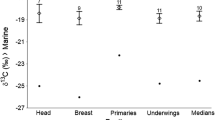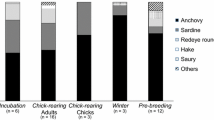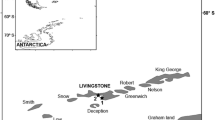Abstract
We used stable isotope tracers in the growing primary feathers of Eurasian Spoonbill chicks (Platalea leucorodia leucorodia) to study seasonal variation in their diet on one of the Frisian islands, Schiermonnikoog, The Netherlands. Using growing individual primaries as natural samplers over time, samples were taken along the length of primary feathers to estimate both within- and between-individual variation in diet. Absolute isotopic ratios of feather material ranged from −26.2 to −14.7 ‰ for carbon (δ13C) and from 13.0 to 18.7 ‰ for nitrogen (δ15N). The variation in δ13C values suggests the use of a variety of feeding habitats, ranging from freshwater to marine. Across the breeding season, there was a shift from predominantly freshwater prey early on to a more marine diet later in the season. Surprisingly, this shift did not occur within the growth trajectory of early born chicks which instead showed the opposite, but it did occur within individual chicks born later in the season. Stable isotope Bayesian mixing-model (SIAR) outcomes demonstrated that the freshwater/brackish prey had the highest isotopic contribution “(51 %; 95 % confidence interval 39–63 %) to the diet early in the breeding season, whereas marine prey contributed most (78 %; 66–89 %) to the diet later. That chicks fed with either freshwater or marine food items had similar body condition indices suggests that the eating of marine prey did not come at a major cost for growing Spoonbill chicks.
Zusammenfassung
Jahreszeitliche Unterschiede in der Nahrungszusammensetzung von Löfflerküken im Wattenmeer: eine Analyse stabiler Isotope
Anhand der Signaturen stabiler Isotope in wachsenden Handschwingen von Löfflerküken (Platalea leucorodia leucorodia) auf Schiermonnikoog, einer der Westfriesischen Inseln (Niederlande), wurden jahreszeitliche Unterschiede in deren Nahrungszusammensetzung untersucht. Da die einzelnen wachsenden Federn praktisch natürliche Zeitreihen darstellen, nahmen wir Proben über die ganze Länge der Handschwingen, um die Variation in der Nahrungszusammensetzung sowohl bezogen auf einzelne Individuen als auch auf die Unterschiede zwischen verschiedenen Tieren abzuschätzen. Die absoluten Isotopenverhältnisse des Federmaterials lagen zwischen −26.2 ‰ und −14.7 ‰ für Kohlenstoff (δ13C) beziehungsweise zwischen 13.0 und 18.7 ‰ für Stickstoff (δ15N). Die Variation der δ13C-Werte deutet darauf hin, dass zur Nahrungssuche eine Vielzahl von Habitaten genutzt werden, die von Süßwasserhabitaten bis zu marinen Lebensräumen reichen. Im Verlauf der Brutsaison kam es zu einer Verschiebung von überwiegend im Süßwasser lebender Beute zu Beginn zu einem stärker marin geprägten Nahrungsspektrum gegen Ende der Brutzeit. Überraschenderweise ereignete sich diese Verschiebung nicht während der Wachstumsphase früh geschlüpfter Küken, bei denen stattdessen das Gegenteil zu beobachten war, sondern zeigte sich bei einzelnen Küken, welche zu einem späteren Zeitpunkt schlüpften. Die Ergebnisse der Bayes’schen Mischmodelle stabiler Isotope (SIAR) zeigten, dass Beute aus Süß- und Brackwasserhabitaten am Anfang der Brutsaison den größten Teil zur Isotopenzusammensetzung beitrug (51 %; 95 %-Konfidenzintervall: 39–63 %), wohingegen später marine Beutetiere den höchsten Anteil am Nahrungsspektrum ausmachten (78 %; 66–89 %). Dass Küken, die mit Süßwassertieren gefüttert wurden, ähnliche Konditionsindizes besaßen wie Küken, die marine Nahrung bekommen hatten, weist darauf hin, dass der Verzehr mariner Beutetiere für wachsende Löfflerküken keinen großen Nachteil darstellt.




Similar content being viewed by others
References
Abraham CL (2008) Relative contribution of euphausiid prey species and timing of breeding to Cassin’s Auklet Ptychoramphus aleuticus growth: within-season effects. J Avian Biol 39:178–188
Altenburg W, Wymenga E (1997) Voedsel voor lepelaars. Rapport Vogelbescherming Nederland 32, Zeist
Barnes GG, Nudds TD (1991) Salt tolerance in American Black Ducks, Mallards, and their F1-hybrids. Auk 108:89–98
Bauchau V, Horn H, Overdijk O (1998) Survival of Spoonbills on Wadden Sea islands. J Avian Biol 29:177–182
Bearhop S, Thompson DR, Waldron S, Russell IC, Alexander G, Furness RW (1999) Stable isotopes indicate the extent of freshwater feeding by Cormorants (Phalacrocorax carbo) shot at inland fisheries in England. J Appl Ecol 36:75–84
Bearhop S, Waldron S, Votier SC, Furness RW (2002) Factors that influence assimilation rates and fractionation of nitrogen and carbon stable isotopes in avian blood and feathers. Physiol Biochem Zool 75:451–458
Beaulieu M, Spee M, Lazin D, Ropert-Coudert Y, le Maho Y, Ancel A, Raclot T (2010) Ecophysiological response of Adelie Penguins facing an experimental increase in breeding constraints. J Exp Biol 213:33–39
Beukema JJ (1992) Dynamics of juvenile Shrimp Crangon crangon in a tidal-flat nursery of the Wadden Sea after mild and cold winters. Mar Ecol Prog Ser 83:157–165
Bryant R, Jones IL, Hipfner JM (1999) Responses to changes in prey availability by Common Murres and Thick-billed Murres at the Gannet Islands, Labrador. Can J Zool 77:1278–1287
Campos J, Bio A, Cardoso J, Dapper R, Witte JIJ, van der Veer HW (2010) Fluctuations of Brown Shrimp Crangon crangon abundance in the western Dutch Wadden Sea. Mar Ecol Prog Ser 405:203–219
Campos J, Moreira C, Freitas F, van der Veer HW (2012) Short review of the eco-geography of Crangon. J Crust Biol 32:159–169
Caut S, Angulo E, Courchamp F (2009) Variation in discrimination factors (delta N-15 and delta C-13): the effect of diet isotopic values and applications for diet reconstruction. J Appl Ecol 46:443–453
Chisholm BS, Nelson DE, Schwarcz HP (1982) Stable-carbon isotope ratios as a measure of marine versus terrestrial protein in ancient diets. Science 216:1131–1132
Craig H (1953) The geochemistry of the stable carbon isotopes. Geochim Cosmochim Acta 3:53–92
Cramp S, Simmons KEL (eds) (1977) Handbook of the birds of Europe, the Middle East and North Africa: the birds of the Western Palearctic, vol 1: ostrich to ducks. Oxford University Press, Oxford
Davoren GK, Burger AE (1999) Differences in prey selection and behaviour during self-feeding and chick provisioning in Rhinoceros Auklets. Anim Behav 58:853–863
de Goeij P, Kemper JH, van Wetten JCJ (1985) De lepelaar in het Waddengebied. Waddenbulletin 20:5–7
Dosch JJ (1997) Salt tolerance of nestling Laughing Gulls: an experimental field investigation. Colon Waterbirds 20:449–457
Eggers S (2000) Compensatory frugivory in migratory Sylvia Warblers: geographical responses to season length. J Avian Biol 31:63–74
El-Hacen EM, Overdijk O, Lok T, Olff H, Piersma T (2013) Home range, habitat selection, and foraging rhythm in Mauritanian Spoonbills (Platalea leucorodia balsaci): a satellite tracking study. Waterbirds 36:277–286
Eriksson BK, van der Heide T, van de Koppel J, Piersma T, van der Veer HW, Olff H (2010) Major changes in the ecology of the Wadden Sea: human impacts, ecosystem engineering and sediment dynamics. Ecosystems 13:752–764
Fridolfsson AK, Ellegren H (1999) A simple and universal method for molecular sexing of non-ratite birds. J Avian Biol 30:116–121
Fry B (2002) Conservative mixing of stable isotopes across estuarine salinity gradients: a conceptual framework for monitoring watershed influences on downstream fisheries production. Estuaries 25:264–271
Fry B (2006) Stable isotope ecology. Springer, Berlin
Fry B, Scalan RS, Parker PL (1983) 13C/12C ratios in marine food webs of the Torres Strait, Queensland. Aust J Mar Freshw Res 34:707–715
Ghosh M, Singh P, Mohan D (2011) Seasonal variation in foraging ecology of three species of overwintering Leaf Warblers (genus Phylloscopus) in the Himalayan foothills. J Ornithol 152:869–877
Gutiérrez JS, Masero JA, Abad-Gomez JM, Villegas A, Sanchez-Guzman JM (2011) Understanding the energetic costs of living in saline environments: effects of salinity on basal metabolic rate, body mass and daily energy consumption of a long-distance migratory shorebird. J Exp Biol 214:829–835
Hancock J, Kushlan J, Kahl M (eds) (1992) Storks, ibises and spoonbills of the world. Academic, London
Hannam KM, Oring LW, Herzog MP (2003) Impacts of salinity on growth and behavior of American Avocet chicks. Waterbirds 26:119–125
Harriman AE (1967) Laughing Gulls offered saline in preference and survival tests. Physiol Zool 40:273–279
Hobson KA, Clark RG (1992) Assessing avian diets using stable isotopes I: turnover of 13C in tissues. Condor 94:181–188
Hobson KA, Welch HE (1992) Determination of trophic relationships within a High Arctic marine food web using delta C13 and delta N15 analysis. Mar Ecol Prog Ser 84:9–18
Hufnagl M, Temming A (2011) Growth in the Brown Shrimp Crangon crangon. II. Meta-analysis and modelling. Mar Ecol Prog Ser 435:155–172
Huntingford FA, Chellappa S, Taylor AC, Strang RHC (2001) Energy reserves and reproductive investment in male Three-spined Sticklebacks Gasterosteus aculeatus. Ecol Freshw Fish 10:111–117
Jaeger A, Connan M, Richard P, Cherel Y (2010) Use of stable isotopes to quantify seasonal changes of trophic niche and levels of population and individual specialisation in seabirds. Mar Ecol Prog Ser 401:269–277
Jensen PM, Madsen P, Jensen LS, Pipper CB (2012) Differences in carbon and nitrogen stable isotope signatures amongst wild and released Pheasant populations. Eur J Wildl Res 58:755–760
Johnston JW, Bildstein KL (1990) Dietary salt as a physiological constraint in White Ibis breeding in an estuary. Physiol Zool 63:190–207
Kemper JH (1995) Role of the Three-spined Stickleback (Gasterosteus aculeatus L) in the food ecology of the Spoonbill Platalea leucorodia. Behaviour 132:1285–1299
Klaassen M, Ens BJ (1990) Is salt stress a problem for waders wintering on the Banc d’Arguin, Mauritania. Ardea 78:67–74
Knoff AJ, Macko SA, Erwin RM, Brown KM (2002) Stable isotope analysis of temporal variation in the diets of pre-fledged Laughing Gulls. Waterbirds 25:142–148
Macarthur RH, Pianka ER (1966) On optimal use of a patchy environment. Am Nat 100:603–609
Massias A, Becker PH (1990) Nutritive value of food and growth in Common Tern (Sterna hirundo) chicks. Ornis Scand 21:187–194
Matheu E, del Hoyo J (1992) Family Threskiornithidae (Ibises and Spoonbills). In: del Hoyo J, Elliot A, Sargatal J (eds) Handbook of the birds of the World, vol 1. Lynx, Barcelona, pp 472–506
Minagawa M, Wada E (1984) Stepwise enrichment of 15 N along food chains: further evidence and the relation between 15 N and animal age. Geochim Cosmochim Acta 48:1135–1140
Mizutani H, Fukuda M, Kabaya Y, Wada E (1990) Carbon isotope ratio of feathers reveals feeding behavior of Cormorants. Auk 107:400–403
Östlund-Nilsson S (ed) (2007) Biology of the three-spined stickleback. CRC, New York
Parnell AC, Inger R, Bearhop S, Jackson AL (2010) Source partitioning using stable isotopes: coping with too much variation. PLoS ONE 5(3):e9672. doi:10.1371/journal.pone.0009672
Piersma T (1980) Lepelaars op de Mokkebank. Vanellus 33:54–57
Piersma T (2012) What is habitat quality? Dissecting a research portfolio on shorebirds. In: Fuller R (ed) Birds and habitat: relationships in changing landscapes. Cambridge University Press, Cambridge, pp 383–407
Piersma T, van der Velde M, El-Hacen EM, Lok T, Overdijk O (2012) Molecular verification of the subspecies status of the Mauritanian Spoonbill Platalea leucorodia balsaci. Ardea 100:131–136
Pinheiro JC, Bates DM (eds) (2000) Mixed-effects models in S and S-Plus. Springer, New York
Post DM (2002) Using stable isotopes to estimate trophic position: models, methods, and assumptions. Ecology 83:703–718
Quillfeldt P, Voigt CC, Masello JF (2010) Plasticity versus repeatability in seabird migratory behaviour. Behav Ecol Sociobiol 64:1157–1164
Schell DM, Saupe SM, Haubenstock N (1989) Bowhead Whale (Balaena mysticetus) growth and feeding as estimated by δ13C techniques. Mar Biol 103:433–443
Schoeninger MJ, Deniro MJ (1984) Nitrogen and carbon isotopic composition of bone collagen from marine and terrestrial animals. Geochim Cosmochim Acta 48:625–639
Smith AD, Donohue K, Dufty AM (2008) Intrafeather and intraindividual variation in the stable-hydrogen isotope (δD) content of raptor feathers. Condor 110:500–506
Steenweg RJ, Ronconi RA, Leonard ML (2011) Seasonal and age-dependent dietary partitioning between the Great black-backed and Herring Gulls. Condor 113:795–805
Thompson DR, Furness RW (1995) Stable-isotope ratios of carbon and nitrogen in feathers indicate seasonal dietary shifts in Northern Fulmars. Auk 112:493–498
Tulp I, Bolle LJ, Meesters E, de Vries P (2012) Brown Shrimp abundance in northwest European coastal waters from 1970 to 2010 and potential causes for contrasting trends. Mar Ecol Prog Ser 458:141–154
Valera F, Wagner RH, Romero-Pujante M, Gutierrez JE, Rey PJ (2005) Dietary specialization on high protein seeds by adult and nestling Serins. Condor 107:29–40
van de Pol M, Wright J (2009) A simple method for distinguishing within- versus between-subject effects using mixed models. Anim Behav 77:753–758
van Dijk K (1995) Voedsel- en rustgebieden van de Lepelaar in Nederland buiten Noord-Holland. Technisch Rapport Vogelbescherming Nederland 14, Zeist
van Gils JA, Spaans B, Dekinga A, Piersma T (2006) Foraging in a tidally structured environment by Red Knots (Calidris canutus): ideal, but not free. Ecology 87:1189–1202
van Wetten JCJ, Wintermans GJM (1986) The food ecology of the Spoonbill. Verslagen en technische gegevens, University of Amsterdam, Amsterdam
Wassenaar LI, Hobson KA (2006) Stable-hydrogen isotope heterogeneity in keratinous materials: mass spectrometry and migratory wildlife tissue subsampling strategies. Rapid Commun Mass Spectr 20:2505–2510
Wiley AE, Ostrom PH, Stricker CA, James HF, Gandhi H (2010) Isotopic characterization of flight feathers in two pelagic seabirds: sampling strategies for ecological studies. Condor 112:337–346
Wiley AE, Welch AJ, Ostrom PH, James HF, Stricker CA, Fleischer RC, Gandhi H, Adams J, Ainley DG, Duvall F, Holmes N, Hu D, Judge S, Penniman J, Swindle KA (2012) Foraging segregation and genetic divergence between geographically proximate colonies of a highly mobile seabird. Oecologia 168:119–130
Acknowledgments
We are grateful to Jort Ossenbaar for assistance during the stable isotope analysis, to Petra de Goeij and many others for their help in the field, to Suzanne Bakker for prey isotope analysis and to Estefania Velilla Perdomo, Rebecca Reurslag and Kees Camphuysen for the analysis of regurgitates. This study was financially supported by the Netherlands Organisation for Scientific Research (NWO-ALW grant nr 81701012, awarded to T.P.), by the Waddenfonds (Metawad and Waddensleutels projects), Vereniging Natuurmonumenten, le Parc National du Banc d’Arguin (PNBA), la Fondation Internationale du Banc d’Arguin (FIBA), the University of Groningen, the NIOZ Royal Netherlands Institute for Sea Research. Our study complied with all the Dutch regulations on animal care and was carried out under licence of the Animal Experimental Committee of the University of Groningen (licence DEC-4752D). We are grateful for the constructive help by anonymous reviewers. Dick Visser made the final drawings.
Author information
Authors and Affiliations
Corresponding author
Electronic supplementary material
Below is the link to the electronic supplementary material.
Rights and permissions
About this article
Cite this article
El-Hacen, EH.M., Piersma, T., Jouta, J. et al. Seasonal variation in the diet of Spoonbill chicks in the Wadden Sea: a stable isotopes approach. J Ornithol 155, 611–619 (2014). https://doi.org/10.1007/s10336-014-1043-y
Received:
Revised:
Accepted:
Published:
Issue Date:
DOI: https://doi.org/10.1007/s10336-014-1043-y




